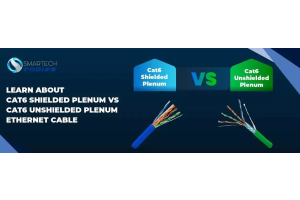The Real Difference between Cat6 and Cat5e Bare Copper Cables

Cat6 and Cat5e bare copper cables are similar in a few aspects and different in a few. Most people assume the difference to be the differences in their performance, however, there is more to it.
It is of course true that the two cables have different performance capabilities, but this basic difference is caused by a number of factors such as the type of conductor used, the number of twists per unit length in the conductor wire, shielding of the cables, and their lengths.
What is the real difference between the Bare Copper Cat6 ethernet network cables and Cat5e ethernet network cables? We will answer in this blog. Let’s get into it.
But first, let’s introduce them.
What is Bare Copper Cat5e Cable?
Enhanced Category 5 ethernet cable, as the name implies is literally an enhanced version of the cat5 ethernet cable.
It was designed to meet the gigabit ethernet requirements at 50 meters and fast ethernet (100Mbps) over 100 meters. The cable is used in both home and office networks but mostly, you will witness its application in domestic networks. However, when it was first introduced, it was a revolutionary networking solution for big business networks with a high-performance requirement.
What is Bare Copper Cat6 Cable?
It is the Category 6 Ethernet Cable that was introduced as an improvement over the previous standardized ethernet cable category 5E. The cable is mainly used in business applications but it is also popular for home local area networks (LAN) with both high and low-performance requirements.
Overall as well, this cable is highly popular among all ethernet cable categories including Cat7 and Cat8. the reason is its affordable cost coupled with its high-performance capabilities over a long duration.
It also comes with a bare copper conductor and in three different types of jackets. Namely, plenum, riser, and PVC.
Cat6 vs Cat5e: Conductor
In both bare copper cables, the conductor is made out of bare copper - as you might guess. And there is no difference in it. However, if Cat6 cable was made out of a copper-clad aluminum conductor and Cat5e was made out of bare copper, both would have been much far more different. The CCA conductor is not ideal for the case in which POE applications are used. It is brittle and heats up which could cause the conductor to break.
On the other hand, the bare copper conductor is more ductile and efficient, almost opposite of its CCA counterpart, which means it can resist heat and would last a long time.
Other than that, the bare copper Cat6 and Cat5e Cables are not entirely different due to the type of conductor.
Cat6 vs Cat5e: Number of twists in the Wires
Now, even if both cables have the same conductors, the number of twists per unit length in both of them is not the same. Cat6 cable has more twists in the conductor pairs as compared to Cat5e.
It is worth mentioning that the greater number of twists means a greater resistance against EMI and external crosstalk. Similarly, a smaller number of twists means a relatively weaker resistance against interference.
Cat6 vs Cat5e: Shielding
Shielding in a cable is a metal foil wrapped around the conductor pairs in an Ethernet cable. It is integrated into networking cables to enhance their performance by reducing the effect of electromagnetic interference and external noise.
Both of the cables are available in shielded and unshielded variants. If you get a Cat6 cable with shielding, it will perform better than an unshielded Cat6 and of course better than a Cat5e as well.
However, if you get a Cat5e cable with shielding, it does not guarantee better performance than an unshielded Cat6.
Cat6 vs Cat5e: Length
The performance of both cables depends on their run length. Cat6 Cable can transmit data at up to 1 Gbps over 100 meters and Cat5e can transmit data at up to 100 Mbps over 100 meters.
If you run the Cat6 cable at 50 meters, you can reach 10 Gigabit speeds, whereas the 5e cable can not exceed gigabit data transfer speeds.
Which one to choose: Cat6 or Cat5e?
Choosing the Cat6 or Cat5e cable depends on your requirements. If you need the cable for a business network, you should definitely go with the bare copper Cat6 cable. On the other hand, if you need it for a small business network or a home network, you can set up an enviable LAN network with the bare copper Cat5e.
Smartech Cables
For cutting-edge ethernet cables or accessories, check out Smartech Cables. We are the industry leader in manufacturing high-performance networking cables and accessories. Our products exceed the industry standards and we are offering market competitive prices. If you need assistance, our professional customer support team is available at sales@smartechcables.com.






